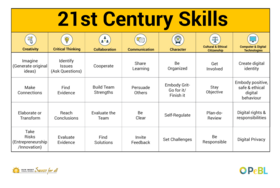Collaboration Guidebook - K-5 (Elementary) Sun West
Purpose
Collaboration is increasingly mentioned as an important educational outcome and most models of 21st century education include collaboration as a key skill. The value of collaboration has been assumed for many years, and over the past two decades we have seen leading businesses and organizations move to facilitate team building and team-based work. The ability to work effectively with others has become a critically important skill for career and life success.
Here is what we know about collaboration and collaborative learning:
- Emphasis on collaboration remains traditional, reflecting older models of interaction
- Use of technology does not always boost collaborative learning or improved digital literacy
- Students learn best from a mix of individual and group-based learning experiences
- Collaboration can enhance the development of critical thinking skills
- Four categories of assessment exist for evaluating collaboration as a process and outcome for both groups and individuals
- Collaborative problem solving is an area to watch with new assessments
Collaboration. P21 Partnership for 21st Century Learning. http://www.p21.org/our-work/4cs-research-series/communication. Web. May 7, 2018
Why it’s important: Students of the digital age are social by nature. They text, post, update, share, chat, and constantly co-create in technological environments with each other. When they are unable to do this in school, they become disengaged and unattached to their learning. Connection and collaboration with others are essential not only to their learning but their mental and emotional health. It is a skill that educators must exercise with them regularly, and understanding Collaboration Fluency will assist with this.
https://globaldigitalcitizen.org/collaboration-fluency-video/
Watanabe-Crockett, Lee. The Critical 21st Century Skills Every Student Needs and Why. Global Digital Citizen Foundation. https://globaldigitalcitizen.org/21st-century-skills-every-student-needs. Aug 2 2016. Web May 6, 2018
Explicit Teaching
To be able to learn and grow in 21st Century Competency understanding, it is important to teach each skill and let students experience what each skill looks like as well as how you can grow in each area. Caution: by simply saying the word "communication or collaboration...etc" students may not get a full understanding of each skill. Explicitly teaching and utilizing skills in different ways is what will ultimately promote deep understanding and growth in 21st Century Competencies.
Timeline Suggestions for Explicit Teaching
The document below provides a year plan to teach each of the 21st century skills. It is beneficial to have an explicit teaching plan to ensure each skill is taught; however skills should also be reinforced as much as possible throughout class time.
Lesson Plans
Cooperate
- Using Tech Tools- have students create posters for the school around cooperation & teamwork. Link to health outcomes. https://www.educatorstechnology.com/2013/02/the-best-10-tools-to-create-posters-for.html
- Together watch and discuss videos that have both positive and negative cooperation. See sample videos below. Use exit slip as formative assessment.
- Create anchor charts of what participating in a group looks like. Group collaboration norms:
- Ask students to give examples of what Collaboration is and is not.
- Students create posters of what Collaboration looks like, sounds like, and feels in in their words.
- As a group, discuss and create (draw) your ideal classroom. Label the important parts.
- Collaboration Games:
- Paper chain challenge – play in teams and see who can make the longest chain in a set amount of time
- Web activity – students sit in a circle and pass a ball of yarn back and forth across the circle, forming a giant web. This leads into discussion about how when we are interconnected and work together we are very strong.
- Pairs or groups have a towel and a beach ball and work together to toss the ball up in the air or to hit targets on the wall
- Students all stand in a circle holding hands. Students must pass a hula-hoop around the whole circle without anyone letting go of hands.
- Chicken tag: a hilarious game for children to play to focus on collaboration and team work. It is a never ending game of tag. What you need: 2 flexible plastic chickens and 2 noodles for 20-3- students. Add more of each item to keep a similar ratio. How to play: Pre teach how to tag with a noodle. Gently, below the shoulder and higher than the waist. Students with the chicken tag. Students with the noodle untag. If a child is tagged with a chicken they must freeze and pretend to be a chicken by squawking and making their arms go up and down like a chicken flying. In order to be unfrozen the student with the noodle needs to gently tag the student! Change up the players frequently to keep interest as the taggers and those who untag will be tired quickly!
- Improv.- teachers sets a scenario with a problem (Eg., lawn mower has ran out of gas). One person starts the scene, then other students jump in with ideas to solve the problem. (I’ll go ges gas-no car though. Next kid comes along with a car and drives (no money). Next kid comes with money, etc.) Student jump in with ideas as they think of them, and it builds on that.
- Students could plan and preform skits reflecting what collaboration is not, and then what it is.
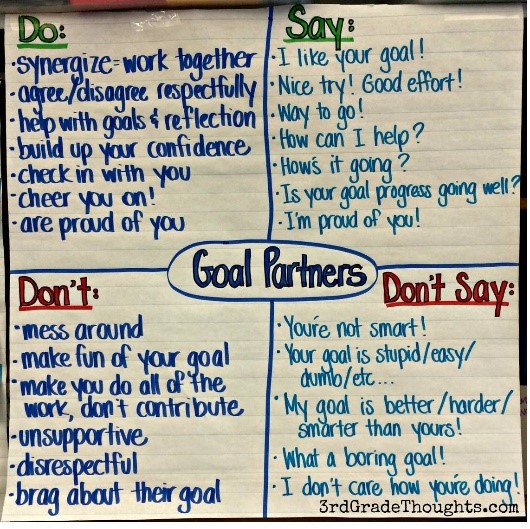
Group Norms
Build Team Strengths
- Collaboration Activity: Are you part of a group or a team?
- Steven Covey’s- 7 Habits of Highly Effective People talk about “Emotional Bank Account”. A good way to talk to students about being a good group member and building on everyone’s strengths. Lots of free activities & youtube videos available for more information and activity ideas.
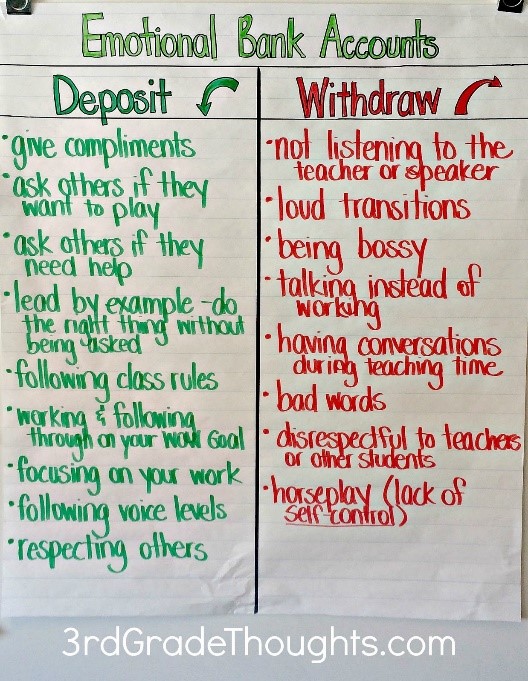
Anchor Chart
Model Collaboration
& practice in short activities:
https://www.edutopia.org/practice/teaching-group-work-building-student-collaboration-and-agency
One of the best ways to train your students to work collaboratively is through game playing. Cooperative classroom games help students become critical thinkers, learn to work with one another and establish a positive classroom environment. The best part? Kids have fun while developing these skills! Sample team building games/activities:
https://www.wrike.com/blog/team-building-games/
Evaluate the Team
Group & Self Assessment Rubrics to open up discussion. Co-create partner assessments according to the group norms you agreed upon.
http://www.readwritethink.org/files/resources/printouts/Group%20and%20Self%20Evaluation.pdf
Teach kids how to celebrate & recognize the good work others have done. Brainstorm a list of ways to celebrate and thank your team.
Find solutions
- Teach Problem Solving Skills & Mindset:
- IDEO Company- IDEO is a global design company. We create positive impact through design. https://www.ideo.com/
- Design Thinking is an approach to addressing challenges in a thoughtful and fun way, where you get to apply the 4Cs -- collaboration, creativity, critical thinking, and communication –- to your own work as you develop new solutions for your classroom, school, and community. https://www.edutopia.org/what-is-design-thinking-for-educators
Integration of Skills
Intentional integration of 21st Century Competency language in all day-to-day activities supports the development of routine reflection, skill use, and growth in support of curricular knowledge acquisition.
Why?
If we do not intentionally integrate 21st Century Competency connections into our learning environments, it is easy to forget about them. As the language becomes routine, growth in skills can and should be explored regularly. Ultimately the 21st Century Competencies are the skills needed to be successful in all day-to-day activities as well as future career opportunities. By being intentional in integrating the language and skill use in all aspects of learning, understanding of the skills can be applied and reflected upon to look for areas of potential growth and application.
How?
Once skills have been explicitly taught, integration of 21st Century Competencies can be achieved by connecting skills to all curricular areas, participating in pre-and post reflections (allowing students to predict which skills will be needed and subsequently which skills need to be worked on) and the use of 21st Century Competency rubrics to track growth.
Example: by using learner profile data, students can reflect on which skills they need to employ for a particular activity and based on this information, choose group members that have strengths or challenges in those skill areas.
Examples
When integrating 21 Century Competency language in all areas of learning consider the following curricular connected resources.
As you use similar resources in your own learning environment, how can you relate them back to growth and understanding of the 21 Century Competencies?
In ELA
In Math
Teachable moments
Whenever a question, situation, comment or activity that involves a connection to a 21 Century Competency arises, take a moment to talk to students about it. Discussing skills, how they integrate into everything you do in life makes the reflection on the importance of skills a habit. This habit will instill a growth mindset around developing skills to their fullest potential. Teachable moments can be as short as 20 seconds. Make it your habit and it will become theirs!
Tracking Growth
When considering 21st Century Competency application, it is essential for both the teacher and the student to track growth. There is clear potential for growth in skill use throughout our lives. To ensure growth and understanding of application is taking place, we can easily track progression using rubrics, checklists, and self-assessments.
Formative Assessment
Formative assessments of 21st Century Competencies include anecdotal documentation, self-assessments and rubric check-ins. These formative assessments provide snapshots of growth throughout the learning process and allow goal setting to take place.
See below for Self-Reflection and Goal Setting documents:
Assessing Growth
Summative Assessment
Exemplar Rubrics
Either share the rubric with your students, or just share the categories and come up with a rubric that is personalized for your class. Post the rubric somewhere that will ensure it is referred to often.
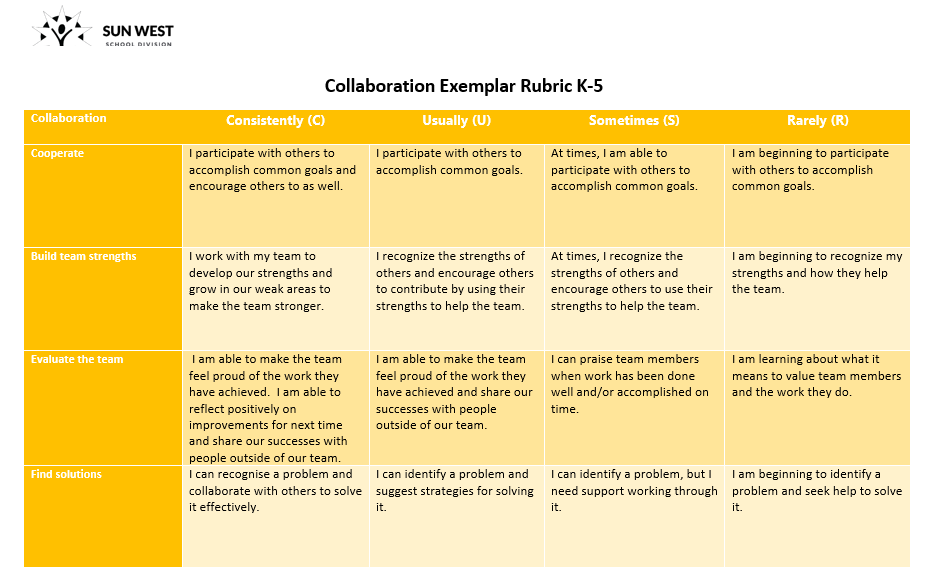
Collaboration K-5
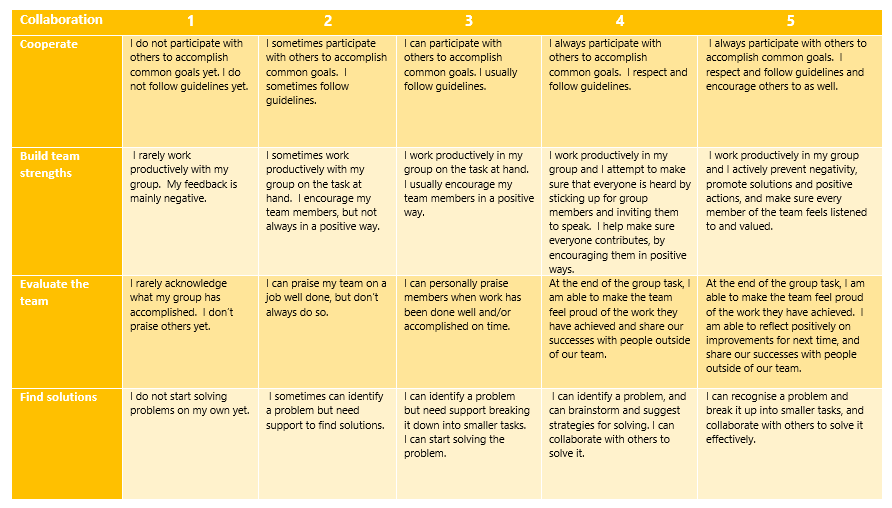
Exemplar Unit
Co-creating Rubrics
Exemplar rubrics have been developed for K-5, 6-9 and 10-12. To connect fully with students in their understanding of skill application and growth, a recommendation would be to re-write the rubric with the students to include their understanding of the skill, goals for integration in learning and commitment to the skill development.
Resources
Setting the Norms for Group Work and Collaboration. This website has posters, and various student inventories and assessments for self-reflection and group reflection.
Sun West Resource Bank Collaboration Resources
Print based
Sun West original print based guidebook
Design Your Classroom For Collaboration in a 21st Century Space
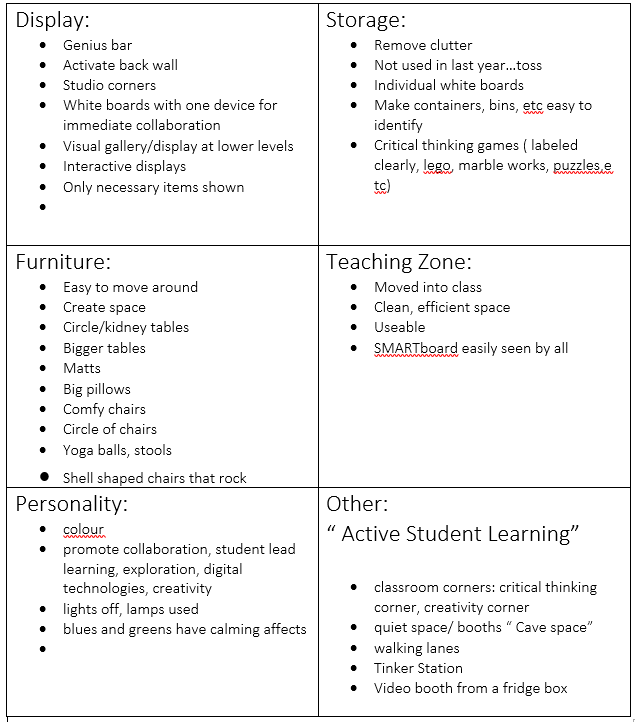
Design Your Classroom for Collaboration
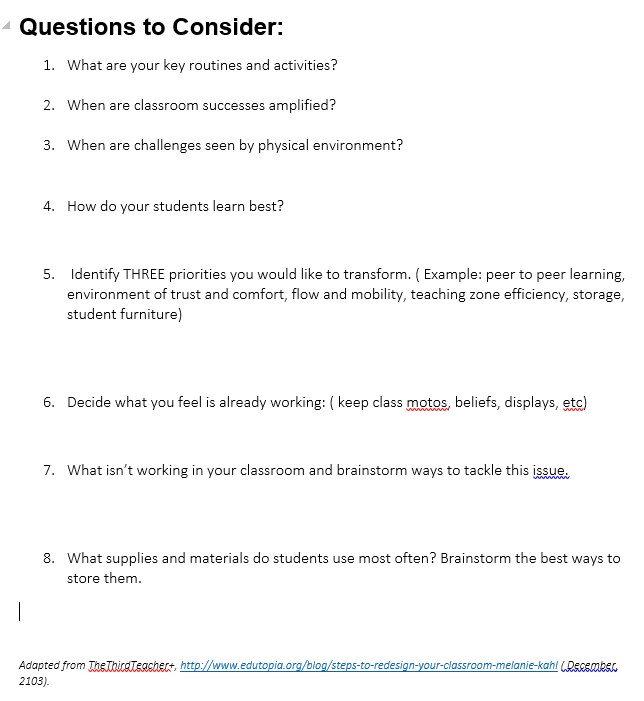
Questions to Consider
Book List:
- Lousy Rotten Sticky Grape
- Frederick- Leo Lionni
- The Enormous Turnip
- Hugo
- Yes I Can
- We Share Everything
- Franklin Plays the Game
- Little Red Hen
Collaboration Fluency Quickstart Skills Guide - Login to the Global Digital Citizen Foundation to download the guide.
Videos
Collaboration: https://www.youtube.com/watch?v=Po40I4c94R0
Leadership and Effective Collaboration
Good teamwork and bad teamwork
Cooperation
Social Skills for 4 to 6 year olds
Work together as a team
Sesame Street: Big Bird sings "That's Cooperation"
Interactive
Educational Articles
Web Sites
Thinking Collaborative - This website has posters and various student inventories and assessments for self-reflection and group reflection.
Critical Thinking and Collaboration Activities - A sample of the many different types of activities to build a collaborative classroom culture.
Edward des Bono’s- Six Thinking Hats is a simple, effective parallel thinking process that helps people be more productive, focused, and mindfully involved. A powerful collaboration tool set, which once learned can be applied immediately! You and your team members can learn how to separate thinking into six clear functions and roles. Each thinking role is identified with a colored symbolic "thinking hat." By mentally wearing and switching "hats," you can easily focus or redirect thoughts, the conversation, or the meeting. Many resources are already created for this strategy. Do a quick google search and many already made activities are ready for you. For example:
http://www.debonogroup.com/six_thinking_hats.php
https://www.youtube.com/watch?v=UZ8vF8HRWE4
